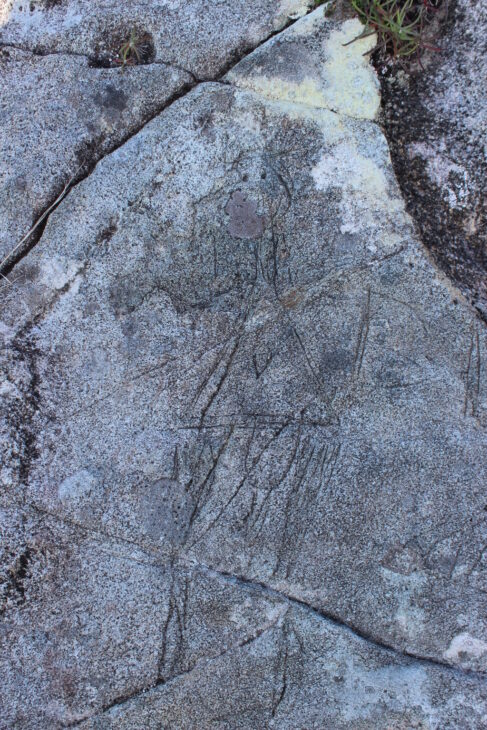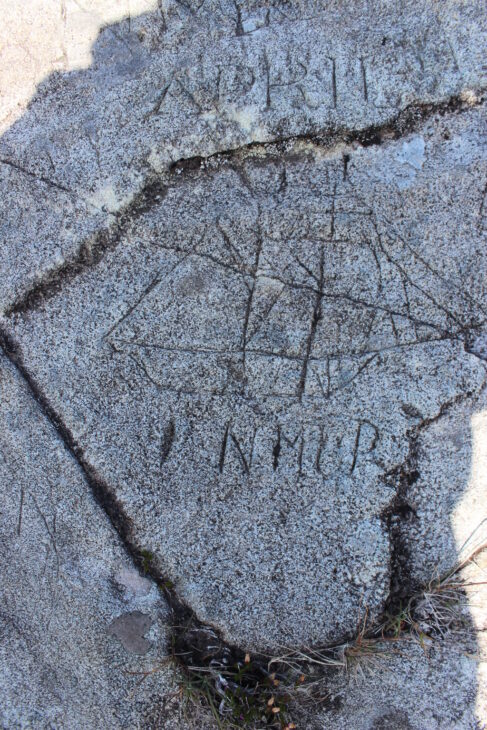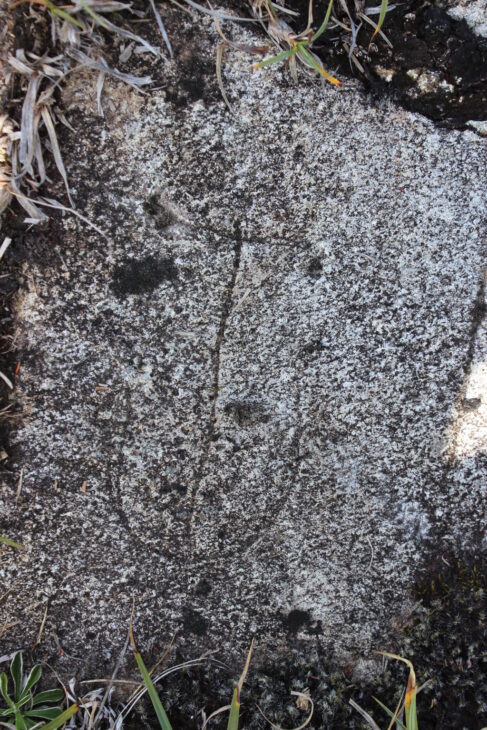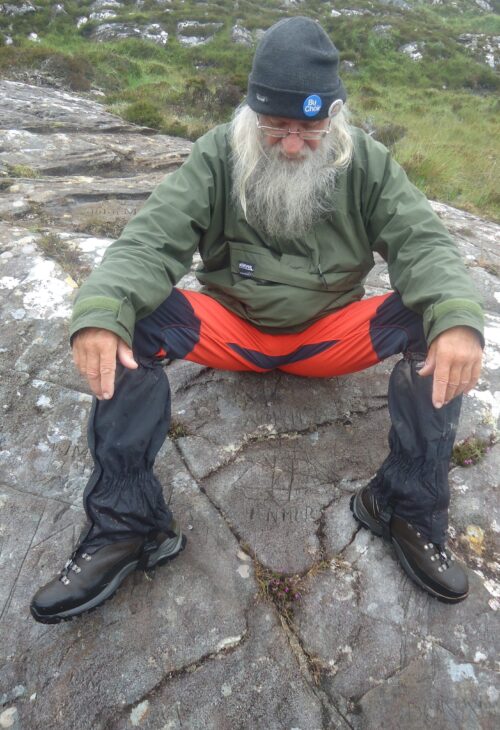Creagan Grabhalta Clach Tuill – Engraved Stones of Clachtoll
,
One of our Community Grants Scheme recipients this year was Griogair MacAllein who led story walks across the area throughout last year. Through these walks, Griogair shared his wealth of knowledge of local folklore and history. Here he shares some thoughts on the Creagan Grabhalta Clach Tuill – the Engraved Stones of Clachtoll:
Although an ‘Aiberdeenshire’ loon born an’ brocht up I now live in Assynt, North West Sutherland. Diverse landscapes, from the mountainous to the low agricultural fields, yet both have the smell of salt air in the wind.
The preference for seeking a new life in North America and the Antipodes witnessed individuals and families from both geographical areas escaping the potato famines and the post political changes of the 1745 Jacobite rebellion. The clearances from the Highlands were often callus and brutal but although possibly under duress some were voluntary.
In the North East the evidence seems to be the lucrative offers of affordable land which tempted the mostly rural population to emigrate.
Near the coastal communities of Clachtoll and Stoer, in NW Assynt there is a large flat stone of Lewisian Gneiss which during the 19th & 20th centuries have been ‘lettered’ with 5 rough engravings of full rigged ships and personal initials: JMCL, N.McK, Bella, JMcK CT {CT-Clachtoll} etc, etc. inclusive of dates including 1841 & 1849. A single caricature depicts the outline of a Highlander in a kilt.

To me it is a haunting place, on a clear day in sight of the Minch and the constant sound of a burn leaving the mountains to join the loch below.
The North East is known for the symbolic standing stones – I’ve spent hours absorbing the atmosphere unique to each site – with distinctive ‘cup marks’ surrounded by the abundance of stone circles.

The Pictish symbols ‘chislet’ onto the stone faces evoke images reminiscent of those ‘lettered’ initials at Clachtoll – The ‘Gneiss’ and ‘Granite’ are silent witnesses to a people!
These are the remnants of the ‘ancients’ – the ‘Creagan Grabhalta Clach tuill’ of the North West are a more recent reminder. Both peoples are past and gone but in the present they remain as testimonies to cultures not too dissimilar

Whilst I can’t find background enough to reveal the lives of the ‘Assynt Chisleters’ I can at least offer some information on some selected folks from Deeside who uprooted and embarked for a new life in North America during the 19th century.
As late as 1908 John MacLennan, a Canadian Gaelic speaker of Highland descent, acted as a Booking & Selling Agent offering plots of land for sale in North America. He travelled as far as the Outer Hebrides and was a ‘kent’ figure as the Fairs and ‘Fee’ing’ markets in the North East and was an annual attendee at the Braemar Gathering.
Life savings could be exchanged for an unsure but potentially prosperous future with no discrimination to both Farm labourers, tradesmen {Blacksmiths, shoe-makers, carpenters etc} and ‘coonter-loupers’ {clerks, shopkeepers etc}.
As much as arable land was a lucrative selling point so to the placement of churches and the respective clergy and schools as in the case of CHARLES FARQUARSON.
Once a tenant at the ‘Parks of Coldstone’, Invercauld Estate, he was reluctantly persuaded by the ‘high handed’ affairs of his landlord to cast his lot in with his brother-in-law JOHN FLETCHER to emigrate .
It was on being informed that the induction of the REV. WILLLIAM TROUP from Ballater the previous year that Farquharson moved in 1864 to Tilbury East, refered to in documents as the ‘Eastern Township’, later to become Ontario.
Some 30 years earlier in 1834, GEORGE ELMSLIE, a merchant in Aberdeen with relatives In Deeside chose to settle in the lands of Fergus Township, also in Tilbury East fully aware that this particular area boasted large colonies of ‘Deesiders’.
JAMES THOMPSON of Aboyne’ and Baker to trade uprooted to North America in 1844 but only after 10 years working for other landowners could he afford, in instalments, ‘862 pounds. 10/-‘ to purchase his own farm.
Fortunate in his endeavours Elmslie paid for his father, sister and her 2 children to make the passage to join him.
PETER WILLIAMSON, perhaps the more familiar of all the emigrants, and in contrast taken against his will to the colonies, later wrote of his experiences :
‘’Know, therefore, that I was born in Hirnlay, in the parish of Aboyne {1743}…. if not of rich, yet of reputable parents….I was sent to live with my aunt in Aberdeen {aged 13} …when playing on the quay I was taken notice of by two fellows belonging to a vessel in the harbor, employed as was the trade then was …in the villainous and execrable practice called Kidnapping. In about a month’s time the ship set sail for America….’
Too much to relate here but Williamson after 16 years was released from his ‘contract ’but subsequently captured by a tribe of Indians before eventually escaping and returning to Aberdeen , earning a reputation performing dressed as a Native American. ‘Indian Peter’, as he was known then moved to Edinburgh where he established himself as a Printer. He died in 1799.
To conclude. I can only assume, as common practice any if not all of the aforementioned persons may have carved their initials onto to the bark of a tree some time or another. Clachtoll and Stoer have little in the way of trees. Stone suffices as a memento for future generations to ponder.
Almost certainly all would have scratched their signatures with quill and ink onto legal documents before preceding on their journeys from East and West – into the hardships of futures’ uncertain.
It is likely that if the corresponding dates on the ‘Creagan Grabhalta Clach tuill’ are correct the Gaels would have been familiar with Robert MacDougall’s Gaelic publication ‘Ceann-Iuil an Fhir Imrich’ – ‘The Emigrant’s Guide To North America’ {1841}.
In the ’Guide’ MacDougall offers advice for the prospective settlers. An extract may be of interest to this Blog:
‘Every man who is going on this journey, then let him bring…plenty of protective clothing and bed clothes, stockings, broad blue bonnets…a large bolt of cotton cloth for shirts, coarse woolen fabric for white vests, blanket fabric for knee breeches, thin canvas fabric for summer trousers…….’
Noo. I winner if, at the time written aboot, the twa Davies’ an’ the ‘Prick-The –Cloot’ loons an’ quines o’ Hill Trek’ wid hiv teen a gee an’, wrappit up the ‘Ventile’ an’ ither sik like an’ traivelled frae Aboyne athort the Atlantic for tae mak’ a name an’some siller?
Time past, Time present. Who knows?

GRIOGAIR MACALLEIN
DECEMBER 2019
